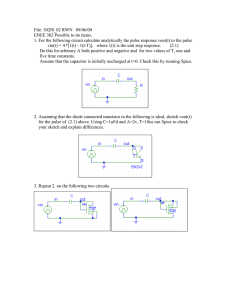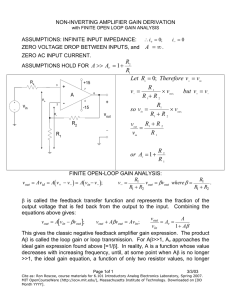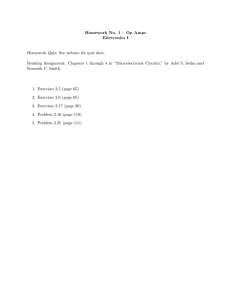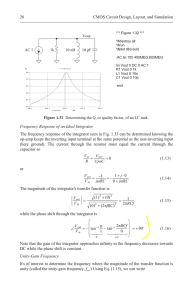Solutions - Olin College
advertisement
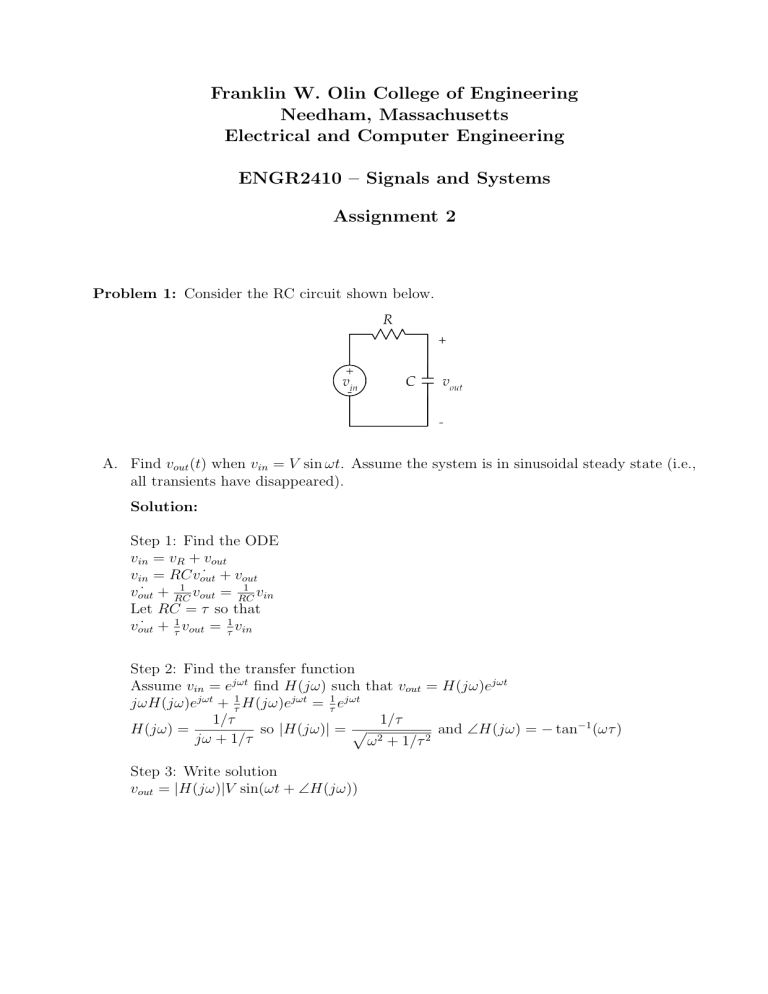
Franklin W. Olin College of Engineering Needham, Massachusetts Electrical and Computer Engineering ENGR2410 – Signals and Systems Assignment 2 Problem 1: Consider the RC circuit shown below. A. Find vout (t) when vin = V sin ωt. Assume the system is in sinusoidal steady state (i.e., all transients have disappeared). Solution: Step 1: Find the ODE vin = vR + vout vin = RC vout ˙ + vout 1 1 vin vout ˙ + RC vout = RC Let RC = τ so that vout ˙ + τ1 vout = τ1 vin Step 2: Find the transfer function Assume vin = ejωt find H(jω) such that vout = H(jω)ejωt jωH(jω)ejωt + τ1 H(jω)ejωt = τ1 ejωt 1/τ 1/τ H(jω) = so |H(jω)| = √ and ∠H(jω) = − tan−1 (ωτ ) 2 jω + 1/τ ω + 1/τ 2 Step 3: Write solution vout = |H(jω)|V sin(ωt + ∠H(jω)) or vout = V √ 1/τ ω2 + 1/τ 2 sin[ωt − tan−1 (ωτ )] B. Assume an input vin = V sin(ωt)u(t) so that the circuit is initially at rest. Find an expression for vout (t) when t > 0. Solution: Step 1: Find particular solution The sinusoidal steady state from the previous part is the particular solution for t > 0. Step 2: Find homogeneous solution Solve vout ˙ + τ1 vout = 0 t Integrate to obtain vout,homogeneous = Ae− τ Step 3: Add the particular solution to the homogeneous solution and use the initial condition to determine the constant of integration A 1/τ t vout = V √ sin[ωt − tan−1 (ωτ )] + Ae− τ , t > 0 2 2 ω + 1/τ vout (0) = 0 1/τ sin[tan−1 (ωτ )] + A 0 = −V √ 2 ω + 1/τ 2 1/τ ω √ A=V√ 2 2 2 ω + 1/τ ω + 1/τ 2 ) ( 1/τ ω t vout = V √ sin[ωt − tan−1 (ωτ )] + √ e− τ , t > 0 2 2 2 2 ω + 1/τ ω + 1/τ 2 C. Plot the solution assuming V = 1, ω = 1, and RC = 1 as well as V = 1, ω = 10, and RC = 1. Solution: vout (ω=1) 1 0.5 0 −0.5 −1 0 1 2 3 0 1 2 3 4 5 6 7 4 5 6 7 vout (ω=10) 0.2 0.1 0 −0.1 −0.2 time (s) 3 Problem 2: Consider the RLC circuit shown below. A. Find a differential equation that relates vin and vout . Solution: ∫ vin − vout vout = C v̇out + dt R L v̇in − v̇out vout = v̈out + RC LC v̇out vout v̇in v̈out + + = RC LC RC 2 v̈out + 2αv̇out + ω0 vout = 2αv̇in α= 1 2RC 1 w0 = √ LC B. Derive an expression for the transfer function from vin to vout . Solution: Assume vin = ejωt find H(jω) such that vout = H(jω)ejωt v̈out + 2αv̇out + ω02 vout = 2αv̇in 1 1 w0 = √ α= 2RC LC 2 jωt − ω H(jω)e + 2αjωH(jω)ejωt + ω02 H(jω)ejωt = 2αjωejωt H(jω) = −ω 2 2αjω + 2αjω + ω02 4 C. Sketch the Bode plot for the transfer function from vin to vout using asymptotic approximations. Solution: 2αjω + 2αjω + ω02 2αjω If ω → 0, then H(jω) ≈ ω02 2αω |H(jω)| = 2 , ∠H(jω) = π/2 ω0 2αjω 2αj If ω → ∞, then H(jω) ≈ − 2 = − ω ω 2α |H(jω)| = , ∠H(jω) = −π/2 ω 2αω 2α Intersection = ⇒ ω = ω0 2 ω0 ω 2α 1 Asymptote value at intersection = ω0 Q but the actual value is H(jω0 ) = 1 |H(jω0 )| = 1, ∠H(jω0 ) = 0 H(jω) = −ω 2 The magnitude of 1/Q determines whether the system resonates or not. If Q ≪ 1, then α ≫ ω0 . This system is overdamped and does not oscillates. It behaves as two first order systems together. 0 |H(jω)| 10 −2 10 −4 10 −3 10 −2 10 −1 0 10 10 1 10 2 10 3 10 ∠ H(jω)/π 0.5 0 −0.5 −3 10 −2 10 −1 10 0 10 frequency (ω) 5 1 10 2 10 3 10 If Q ≫ 1, then α ≪ ω0 . This system is underdamped and resonates. 0 |H(jω)| 10 −2 10 −4 10 −3 10 −2 10 −1 0 10 10 1 10 2 10 3 10 ∠ H(jω)/π 0.5 0 −0.5 −3 10 −2 10 −1 10 0 10 frequency (ω) 6 1 10 2 10 3 10

